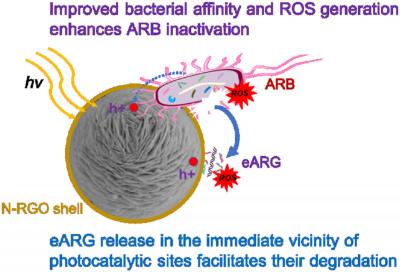Researchers at Rice University design a "shield" made of graphene oxide, that helps particles destroy antibiotic-resistant bacteria and free-floating antibiotic resistance genes in wastewater treatment plants.

The labs of Rice environmental scientist Pedro Alvarez and Yalei Zhang, a professor of environmental engineering at Tongji University, Shanghai, introduced these microspheres wrapped in graphene oxide. Alvarez and his partners in the Rice-based Nanosystems Engineering Research Center for Nanotechnology-Enabled Water Treatment (NEWT) have worked toward quenching antibiotic-resistant "superbugs" since first finding them in wastewater treatment plants in 2013.
"Superbugs are known to breed in wastewater treatment plants and release extracellular antibiotic resistance genes (ARGs) when they are killed as the effluent is disinfected," Alvarez said. "These ARGs are then discharged and may transform indigenous bacteria in the receiving environment, which become resistome reservoirs.
"Our innovation would minimize the discharge of extracellular ARGs, and thus mitigate dissemination of antibiotic resistance from wastewater treatment plants," he said.
The Rice lab showed its spheres - cores of bismuth, oxygen and carbon wrapped with nitrogen-doped graphene oxide - inactivated multidrug-resistant Escherichia coli bacteria and degraded plasmid-encoded antibiotic-resistant genes in secondary wastewater effluent.
The graphene-wrapped spheres kill the harmful bacteria in effluent by producing three times the amount of reactive oxygen species (ROS) as compared to the spheres alone.
The spheres themselves are photocatalysts that produce ROS when exposed to light. Lab tests showed that wrapping the spheres minimized the ability of ROS scavengers to curtail their ability to disinfect the solution.
The researchers said nitrogen-doping the shells increases their ability to capture bacteria, giving the catalytic spheres more time to kill them. The enhanced particles then immediately capture and degrade the resistant genes released by the dead bacteria before they contaminate the effluent.
"Wrapping improved bacterial affinity for the microspheres through enhanced hydrophobic interaction between the bacterial surface and the shell," said co-lead author Pingfeng Yu, a postdoctoral research associate at Rice's Brown School of Engineering. "This mitigated ROS dilution and scavenging by background constituents and facilitated immediate capture and degradation of the released ARGs."
Because the wrapped spheres are large enough to be filtered out of the disinfected effluent, they can be reused, Yu said. Tests showed the photocatalytic activity of the spheres was relatively stable, with no significant decrease in activity after 10 cycles. That was significantly better than the cycle lifetime of the same spheres minus the wrap.